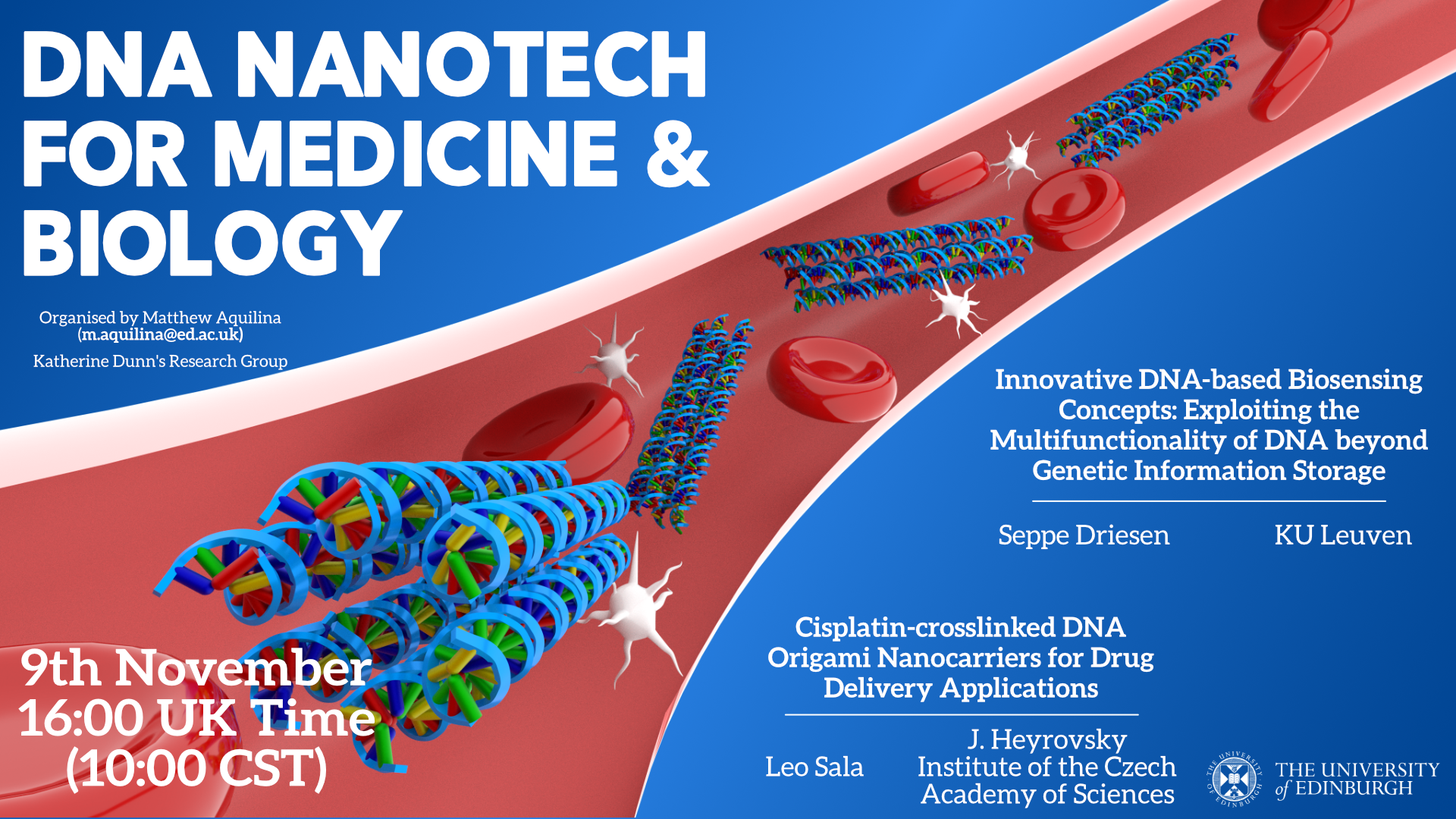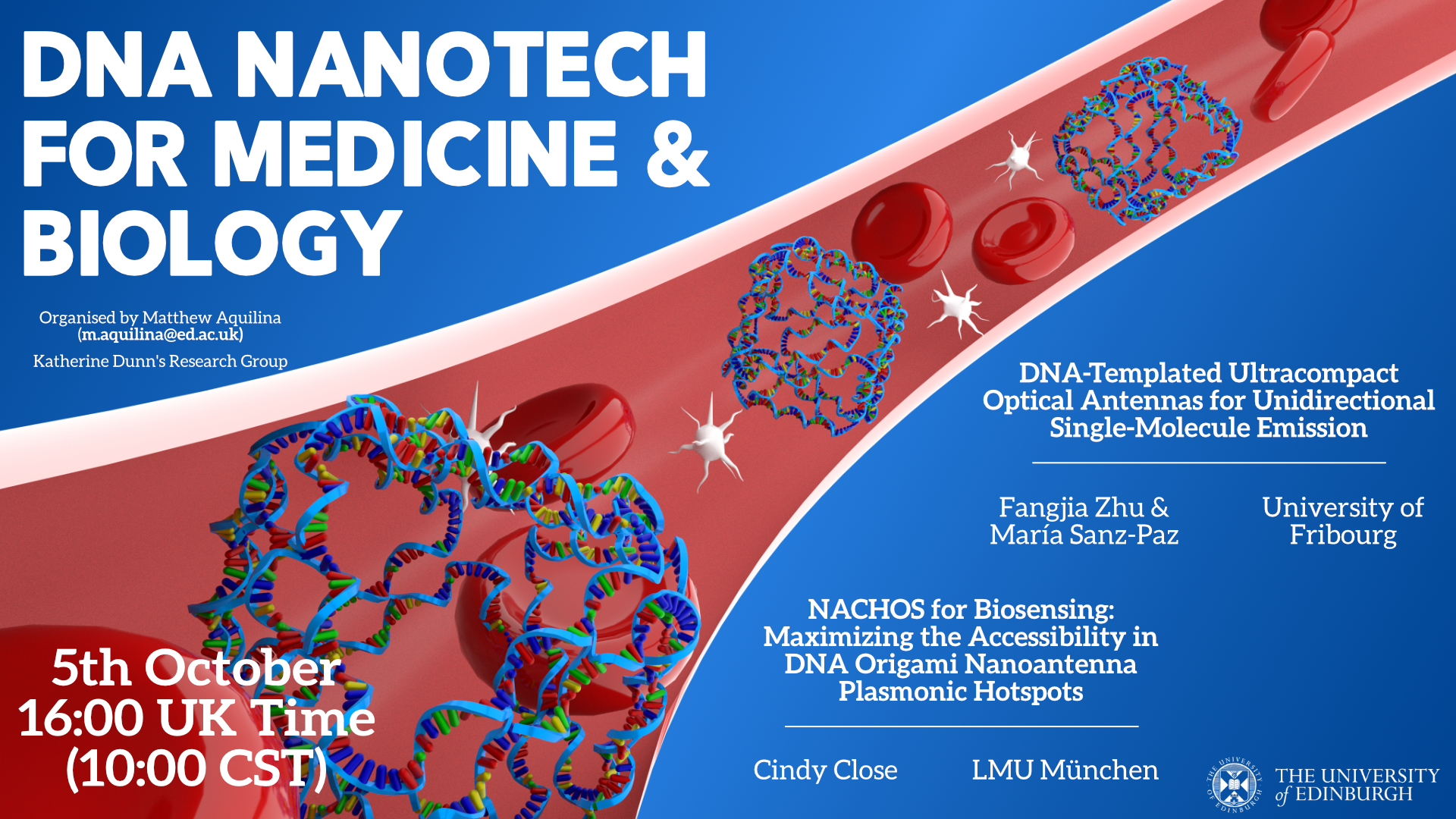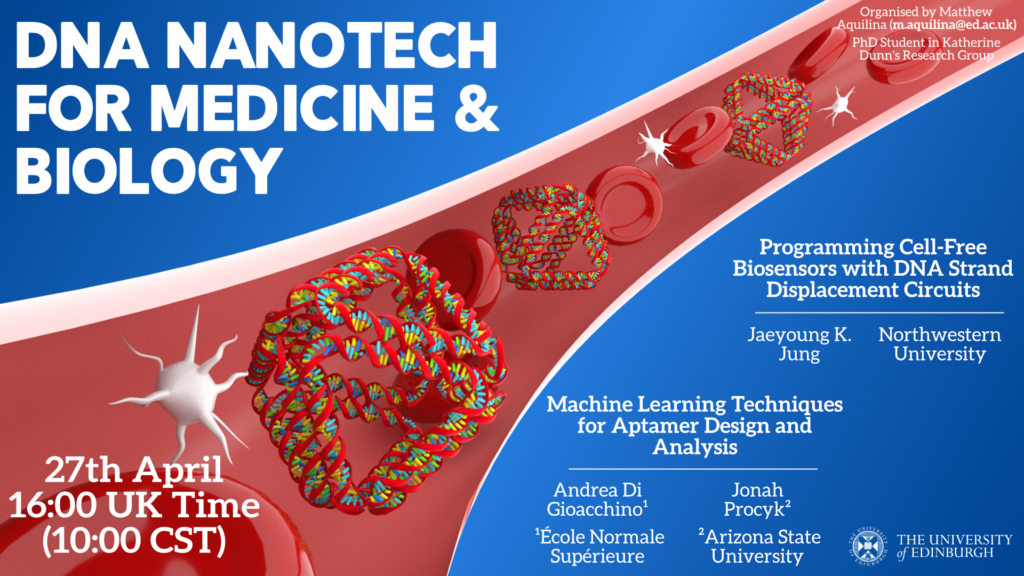Previous Webinars
2022
November 9th Watch Recording Here
- Seppe Driesen – KU Leuven
- Innovative DNA-based Biosensing Concepts: Exploiting the Multifunctionality of DNA beyond Genetic Information Storage
- Leo Sala – J. Heyrovsky Institute of the Czech Academy of Sciences
- Cisplatin-crosslinked DNA Origami Nanocarriers for Drug Delivery Applications
Talk Abstracts
Innovative DNA-based Biosensing Concepts: Exploiting the Multifunctionality of DNA beyond Genetic Information Storage: Since the advent of the biosensing field over 50 years ago, biosensors have become widespread analytical tools for the detection of biomolecules in various settings, ranging from healthcare to environmental monitoring. Despite their undeniable use in our daily life, biosensors are still troubled by several unsolved challenges in the field. Many of these are related to the use of protein components in biosensors, such as antibodies or enzymes, which are typically used for target recognition and (amplified) signal generation, respectively. Additionally, there is an ongoing quest for technologies that enable sensitive detection of multiple biomarkers simultaneously. In this context, DNA nanotechnology has recently been studied to develop more sensitive and robust biosensors for multiplex target detection. In our work, we show that by integrating and combining several concepts from the DNA nanotechnology toolbox, improved biosensing concepts can be developed. For example, aptamers and nucleic acid enzymes (NAzymes) can take over the role of the conventionally used antibodies and protein enzymes. Moreover, the unmatched spatial control offered by DNA origami nanostructures can be exploited to improve the organization of biosensing surfaces at the nanoscale. By integrating these concepts with existing biosensing methodologies such as (fiber-optic) surface plasmon resonance or bead-based digital bioassays, we show the potential of DNA nanotechnology as a tool for developing improved biosensors.
Cisplatin-crosslinked DNA Origami Nanocarriers for Drug Delivery Applications: As a chemotherapeutic agent, cisplatin necessitates efficient delivery to tumor cells since it is also toxic to healthy cells. DNA origami nanocarriers are viable vehicles for such agents because they present opportunities for passive targeting by the enhanced permeability and retention effect and more specific targeting by functionalization. We use a relatively simple method to load cisplatin into DNA origami nanotriangles and we observe that cisplatin can act both as a cross-linker and a chemotherapeutic agent. The cross-linked system shows cytotoxic behavior in the nanomolar range in a FaDu cell line. We plan to determine in the future whether this system can be used in radiotherapy as cisplatin is often employed as a model to study synergistic effects in concomitant chemo- and radiotherapy in cancer treatment. Some strategies for radiosensitization studies using DNA origami nanoplatforms done in our group will also be presented to investigate the use of other potential radiosensitizers.

October 5th Watch Recording Here
- Fangjia Zhu & María Sanz-Paz – University of Fribourg
- DNA-Templated Ultracompact Optical Antennas for Unidirectional Single-Molecule Emission
- Cindy Close – LMU München
- NACHOS for Biosensing: Maximizing the Accessibility in DNA Origami Nanoantenna Plasmonic Hotspots
Talk Abstracts
DNA-Templated Ultracompact Optical Antennas for Unidirectional Single-Molecule Emission: Optical antennas are nanostructures designed to manipulate light−matter interactions by interfacing propagating light with localized optical fields. In recent years, numerous devices have been realized to efficiently tailor the absorption and/or emission rates of fluorophores. By contrast, modifying the spatial characteristics of their radiation fields remains challenging. Successful phased array nanoantenna designs have required the organization of several elements over a footprint comparable to the operating wavelength. In our recent publication, we have reported unidirectional emission of a single fluorophore using an ultracompact optical antenna. The design consists of two side-by-side gold nanorods self-assembled via DNA origami, which also controls the positioning of the single fluorophore. Our results show that when a single fluorescent molecule is positioned at the tip of one nanorod and emits at a frequency capable of driving the antenna in the antiphase mode, unidirectional emission with a forward to backward ratio of up to 9.9 dB can be achieved.
NACHOS for Biosensing: Maximizing the Accessibility in DNA Origami Nanoantenna Plasmonic Hotspots: We show the next evolutionary step in the development of DNA origami structures for single-molecule-based plasmonic biosensing. In our Trident NanoAntenna with a Cleared HOtSpot (NACHOS), we establish improved accessibility to the hotspot region. Adjusting the size of the cleared hotspot improves kinetics of target molecule binding, while ensuring high fluorescence enhancement. As one examplary application of Trident NACHOS in biomolecular assays, we demonstrate a sandwich hybridization assay with a diagnostically relevant 151 nucleotide ssDNA sequence.

September 7th Watch Recording Here
- Michael Pinner – Technical University of Munich
- A DNA-Based Artificial Membrane Budding System
- Gabriel Antonio S. Minero – Aarhus University
- DNA Size Matters: Using Anisotropy of Magnetic Nanoparticles for Detection of DNA Amplification and Folding
Talk Abstracts
A DNA-Based Artificial Membrane Budding System: Scaffolded DNA Origami is the art of manufacturing well defined 3D-structures on the nanoscale using DNA as a building material. The relative ease of producing these nanostructures expands the experimental toolkit on the nanoscale and enables synthetic biology applications, among which we are particularly interested in means to manipulate lipid bilayers. Previous work demonstrated deformation of giant unilamellar lipid vesicles (GUVs) in response to origami structures. Using DNA origami triangles with the ability to self-assemble into icosahedral shells, we aim to create a fully artificial lipid membrane budding system. Our triangular origami shares structural core properties with the cellular vesicle sculpting protein clathrin, namely the ability to form cage-like assemblies with a pre-defined curvature encoded within the structure. The programmability of DNA origami allowed us to easily functionalise our structure for lipid membrane tethering and fluorescence-based analysis. We show that self-assembly of membrane tethered triangles gives rise to DNA-lipid hybrid structures consisting of DNA exoskeletons enclosing vesicular cargo. The size difference between lipid donors (> 1 µm) and the origami structures (approx. 80-100 nm) suggests a budding-like mechanism.
DNA Size Matters: Using Anisotropy of Magnetic Nanoparticles for Detection of DNA Amplification and Folding: Fluorescence quantification, e.g. using Picogreen DNA binding stain, is a robust gold standard method for detection and quantification of bulk DNA in many applications including real-time PCR. However, Picogreen as well as other intercalating fluorescent stains are designed for binding double-stranded DNA, and thus insensitive for non B-DNA conformations. Furthermore, DNA binding stains have an impact on DNA conformation and DNA-enzyme interactions. Thus, alternative biosensors for DNA detection and quantification are being developed. We present applications of optomagnetic technique in DNA detection and studies of (i) enzymology of DNA polymerases, (ii) DNA nanoflower superstructure, and (iii) triplex DNA nanoswitches.

July 27th Watch Recording Here
- Neha Chauhan – University of Illinois at Urbana-Champaign
- Design and Synthesis of Net-Shaped DNA Nanostructures for SARS-CoV-2 Rapid Detection and Potent Inhibition
- Yongzheng Xing – University College London
- Designer DNA Origami Nanopores for Portable Sensing of Diagnostic Proteins
Talk Abstracts
Design and Synthesis of Net-Shaped DNA Nanostructures for SARS-CoV-2 Rapid Detection and Potent Inhibition: The need for high performance antigen tests for virus diagnostics was evident in the recent spread of the highly contagious SARS-CoV-2 virus. The nanomaterials and nanotechnology can provide novel solutions to improve their performance in point-of-care (POC) settings and with high sensitivities. We present a “three-layer” Designer DNA Nanostructure (DDN) design principle and strategy for selective recognition and high-affinity capture of intact SARS-CoV-2 virions through pattern-matching and multivalent interactions among DDN bound aptamers and viral surface displayed trimeric spikes. The aptamers are designed to release fluorescent signal upon virus binding measured by a hand-held fluorimeter for a rapid (in 10 mins), simple (mix-and-read), sensitive (PCR equivalent), and inexpensive (~ $1.26/test) COVID-19 test assay. The DDN-aptamer was also shown to inhibit authentic wild type SARS-CoV-2 infection in cell culture with a ~1000-fold enhancement of the monomeric aptamer. Furthermore, the DDN’s can be customized to tackle other life-threatening and economically influential viruses like influenza and HIV, whose surfaces carry class-I viral envelope glycoproteins like the SARS-CoV-2 spikes in trimeric forms.
Designer DNA Origami Nanopores for Portable Sensing of Diagnostic Proteins: Membrane nanopores are key for molecular transport in biology, portable DNA sequencing, label-free single-molecule analysis and nanomedicine. Transport traditionally relies on barrel-like channels of a few nanometres width but there is considerable scientific and technological interest for wider structures of tuneable shape. Yet, these nanopores do not exist in nature and are challenging to build using existing de novo routes for proteins. To address this challenge, herein we explore the designability and functionality of DNA nanotechnology and develop a modular strategy to align tunable DNA helix-bundled subunits to form confined polygonal shapes, and generate a series of nanopore structures with well-defined sizes and geometries. By taking advantage of the rational functionality of these DNA nanostructures, we can precisely place the recognition site of a protein analyte inside the nanopore lumens, and the protein analyte can be directly detected by specific binding events. Finally, by optimizing the working conditions of the DNA nanopores, we demonstrate the utility and potential of the custom-engineered pores by direct single-molecule sensing of 10 nm-sized proteins with widely used research and handheld analysis devices.

April 27th Watch Recording Here
- Jaeyoung K. Jung – Northwestern University
- Programming Cell-Free Biosensors with DNA Strand Displacement Circuits
- Andrea Di Gioacchino (École Normale Supérieure) & Jonah Procyk (Arizona State University)
- Machine Learning Techniques for Aptamer Design and Analysis
Talk Abstracts
Programming Cell-Free Biosensors with DNA Strand Displacement Circuits: Cell-free biosensors are powerful platforms for monitoring human and environmental health. Here, we expand their capabilities by interfacing them with toehold-mediated strand displacement circuits, a dynamic DNA nanotechnology that enables molecular computation through programmable interactions between nucleic acid strands. We develop design rules for interfacing a small molecule sensing platform called ROSALIND with toehold-mediated strand displacement to construct hybrid RNA–DNA circuits that allow fine-tuning of reaction kinetics. We use these design rules to build 12 different circuits that implement a range of logic functions (NOT, OR, AND, IMPLY, NOR, NIMPLY, NAND). Finally, we demonstrate a circuit that acts like an analog-to-digital converter to create a series of binary outputs that encode the concentration range of the molecule being detected. We believe this work establishes a pathway to create ‘smart’ diagnostics that use molecular computations to enhance the speed and utility of biosensors.
Machine Learning Techniques for Aptamer Design and Analysis: Selection protocols such as SELEX, where molecules are selected over multiple rounds for their ability to bind to a target molecule of interest, are popular methods for obtaining binders for diagnostic and therapeutic purposes. With the increasing amount of such high-throughput experi- mental data available, machine learning techniques have become increasingly popular for molecular datasets analysis. In this talk we will discuss the training of Restricted Boltzmann Machines (RBMs), a two-layer neural network architecture, on sequence ensembles from SELEX experiments for thrombin aptamers, and the usage of RBMs to estimate the fitness of the sequences obtained through the experimental protocol. As a direct consequence, we will show that trained RBMs can be exploited to classify as well as generate novel molecules. Finally, we will discuss experimental verification of the generated sequences from RBM.

March 23rd Watch Recording Here
- Filip Boskovic – University of Cambridge
- Self-Assembled RNA Origami-Based Codes for Exploring RNA Diversity
- Anastasia Ershova – Harvard University
- Multi-Micron Crisscross Structures from Combinatorially Assembled DNA-Origami Slats
Talk Abstracts
Self-Assembled RNA Origami-Based Codes for Exploring RNA Diversity: RNA is a key player in the transfer of information and regulation of biological processes underlined by the immense potential for RNA-based therapeutics and functional RNA nanostructures. Identifying RNA requires intricate protocols that suffer from various enzymatic biases and lead to irreversible loss of native information of RNA presence and quantity. Here we design three-dimensional molecular constructs that enable identification of native RNA at the single-molecule level using solid-state nanopore microscopy. Target RNA is refolded into RNA origami codes with designed sets of complementary DNA strands. Each RNA code has a set of bits that correspond to the size of uncomplemented RNA structures. Nanopore microscope identification works via voltage-driven translocation of negatively charged RNA codes through a small orifice towards a positively charged electrode in an electrolyte solution. It translates RNA code into a current signal with a spatial resolution comparable to complex optical microscopies with higher throughput and straightforward origami assembly. We employed RNA codes and identified multiple RNA variants of messenger RNA and long non-coding RNA in human cervical adenocarcinoma. Our approach has the potential to discriminate up to 10 billion unique RNAs multiplexed pathogen detection, for vaccine byproducts, cancer diagnosis, and as an ultrarapid native RNA characterization technique.

February 16th Watch Recording Here
- Roger Rubio – Imperial College, London
- Regulating Functional DNA-Lipid Interactions with Cations
- Rishabh M. Shetty – Palamedrix (presented work when at Arizona State University)
- $1 Fabrication of Large-Scale Single-Molecule Arrays for High-Throughput Digital Assays
Talk Abstracts
Regulating Functional DNA-Lipid Interactions with Cations: The interplay between nucleic acids and lipids underpins several key processes in molecular biology, synthetic biotechnology, vaccine technology, and nanomedicine. Much of the rich phenomenology arising from these, often electrostatic, interactions remains unexplored given the chemical diversity of lipids, the heterogeneity of their phases, and the broad range of relevant solvent conditions. In this talk, I will discuss our work unraveling and modulating electrostatic interactions between zwitterionic lipid membranes and DNA nanostructures. We identified new routes to program DNA–lipid complexation and membrane-active nanodevices, and elucidate the role of the lipid membrane phase as well as ion valency. We observe divalent cation bridging between nucleic acids and gel-phase bilayers, which can be regulated through several independent physico-chemical parameters. We find that, even in the presence of hydrophobic modifications on the DNA, cations are still required to facilitate DNA adhesion to liquid-phase membranes. The latter mechanism can be exploited to control the degree of attachment of cholesterol-modified DNA nanostructures by modifying their overall hydrophobicity and charge. Besides their biological relevance, the interaction mechanisms we explored hold great practical potential in the design of biomimetic nanodevices, as we demonstrate by constructing an ion-regulated DNA-based synthetic enzyme.
$1 Fabrication of Large-Scale Single-Molecule Arrays for High-Throughput Digital Assays: One of the single-most insightful and visionary talks of the 20th century, “There’s plenty of room at the bottom,” by Dr. Richard Feynman, represented a first foray into the micro-and nano-worlds of biology and chemistry with the intention of direct manipulation of their individual components. Even so, for decades there has existed a gulf between the bottom-up molecular worlds of biology and chemistry, and the top-down world of nanofabrication. Creating single molecule nanoarrays at the limit of diffraction could incentivize a paradigm shift for experimental assays. However, such arrays have been nearly impossible to fabricate since current nanofabrication tools lack the resolution required for precise single-molecule spatial manipulation. What if there existed a molecule which could act as a bridge between these top-down and bottom-up worlds? At ~100-nm, a DNA origami macromolecule represents one such bridge, acting as a breadboard for the decoration of single molecules with 3-5 nm resolution. It relies on the programmed self-assembly of a long, scaffold strand into arbitrary 2D or 3D structures guided via approximately two hundred, short, staple strands. Once synthesized, this nanostructure falls in the spatial manipulation regime of a nanofabrication tool such as electron-beam lithography (EBL), facilitating its high efficiency immobilization in predetermined binding sites on an experimentally relevant substrate. This placement technology, however, is expensive and requires specialized training, thereby limiting accessibility for academic researchers. The work described here introduces a method for bench-top, cleanroom/lithography-free, DNA origami placement in meso-to-macro-scale grids using tunable colloidal nanosphere masks and organosilane-based surface chemistry modification. Bench-top DNA origami placement is the first demonstration of its kind which facilitates precision placement of single molecules with high efficiency in diffraction-limited sites at a cost of $1/chip. The comprehensive characterization of this technique, and its application as a robust platform for high-throughput biophysics as well as its potential for digital biomarker counting are discussed here. In the future, this technique may serve as a template for the bottom-up fabrication of invaluable biophysical tools such as zero mode waveguides, making them significantly cheaper and more accessible to the scientific community. It is our hope that this platform will accelerate democratization of high-throughput single molecule experiments in laboratories worldwide, serving research interests spanning a variety of fields.
